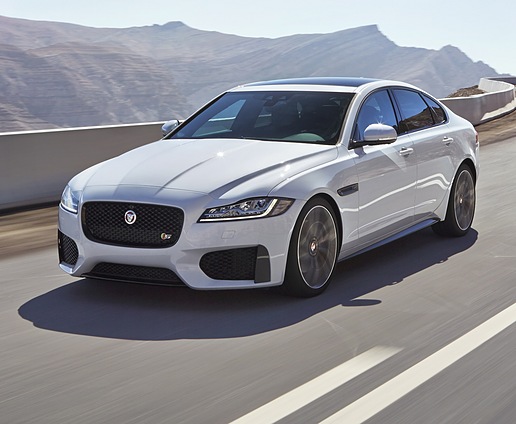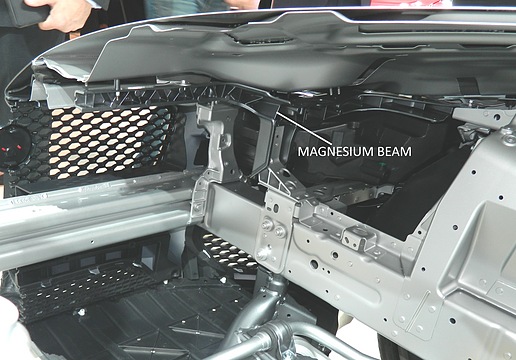 捷豹XF采用铝制车身,外貌酷似轿跑,但后座空间比旧款更大,头部空间提高1.1英寸。
捷豹XF采用铝制车身,外貌酷似轿跑,但后座空间比旧款更大,头部空间提高1.1英寸。 如图所示,XF的引擎盖防撞横梁与仪表板跨车头横梁用镁材料制作而成。
如图所示,XF的引擎盖防撞横梁与仪表板跨车头横梁用镁材料制作而成。 后座侧板用钢材料制作,以平衡整车重量。为实现这目标,捷豹采用了多步骤的接合工艺,以防止侧板与铝制车身的接触腐蚀。
后座侧板用钢材料制作,以平衡整车重量。为实现这目标,捷豹采用了多步骤的接合工艺,以防止侧板与铝制车身的接触腐蚀。 XF前轮驱动款车型的分动器加入了流畅度更高的链式驱动装置,以替换齿轮驱动。
XF前轮驱动款车型的分动器加入了流畅度更高的链式驱动装置,以替换齿轮驱动。 XF的前部结构与进行过加强的A柱相结合,以更好地分散冲撞能量。
XF的前部结构与进行过加强的A柱相结合,以更好地分散冲撞能量。
捷豹正在将其畅销车型XF的钢制车身更换成铝制硬壳式架构,并用在新款XE和XJ身上。这是这家豪华车制造商为符合欧美排放标准所作出的最新努力之一。这辆预计今年冬季上市的新车已在2015年纽约车展上首次公开亮相。XF的尺寸为中大型,正好介于全尺寸XJ与中型XE之间。
XF的全白车身中含有75%的铝,其中大部分铝为RC5754,这是一种将报废铝重新加工制成的铝,而新材料的成分非常低。这些来自于捷豹冲压车间的再生铝构成了5000系列可锻合金(铝和镁)的重要组成部分,捷豹将其用于XF,以提高车身和底座的坚固程度。
钢材被用于重量分配
钢材的应用位置包括车尾底座、行李箱盖以及后座板,这样不仅能满足一些特殊的工程需求,而且还能平衡前后车身的重量。XF的设计重量分配为前半段51%,后半段49%。
钢板与铝制车身搭配显然需要防止接触腐蚀,而捷豹采用了一种基于航空加工技术的五步工艺。第一步是在钢材上镀锌,接着用结构粘合剂制作节点,并对整个车身实施电镀,随后进行缝隙密封,最后完成车身喷涂。全车身没有使用焊接,取而代之的是自钻铆接工艺。
车身侧板由高强度6000系列铝合金单片冲压而成,这是一种内含镁和硅的可锻合金。单块侧板的重量小于6公斤(13磅)。
捷豹将特定的高强度铝合金用于前后防撞结构与A柱和B柱。前部结构与A柱的节点被设计成可分散撞击能量的大块形状。此外,B柱也得到了超高强度(硼)钢结构的巩固,且其中填充高密度泡沫。前悬挂塔由高压压铸铝制成,以提高该区域的坚固程度。
横跨车头的仪表板横梁,以及引擎盖的防撞横梁都由金属镁制成。
精准铆接,提升硬度
捷豹在其车身结构上安装侧板的第一步是精确定位铆接点,这样最终呈现出的是一个具有一定扭转度的坚硬车身。捷豹声称2016款在上一款车型基础上改进了28%,每1度表面弯曲均有21.7千牛·米(16,000磅·英尺)扭矩。
安静是捷豹素有的优点,因此设计时必须尽可能排除噪音。比如说,捷豹用密封双壁结构制作车头前隔壁后方的碰撞结构。首先在盒状铝制结构件中冲入泡沫填充物,当车身进入电镀烤炉中加热时,这些泡沫就会膨胀填满结构件内部。在其他位置,捷豹使用泡沫喷涂的方法来减少噪音,这种工艺比胶泥板重量更轻,但同样可以达到理想的降噪效果。
捷豹称,新款XF比同级竞品轻80公斤(176磅)左右,比钢制车身的上一款XF轻190公斤(419磅)。后轮驱动款XF的整车重量为1770公斤(3902磅),全轮驱动款为1880公斤(4145磅)。
XF的阻力系数也从0.29降到了0.26。前保险杠通风口上的一个辅助部件可引导气流,使其顺畅地流经前轮上方,而不必在车轮周围形成紊流和阻力。
新款XF总长为4956毫米(195.1英寸),比上一款要短,其轴距为2962毫米(116.6英寸),比上一款长了51毫米(2.0英寸),但总长减少了84毫米(3.3英寸)。车辆后座的腿部空间增加了15毫米(0.6英寸),为951毫米(37.4英寸)。尽管XF的外形很像轿跑,但其头部空间仍比上一款多出了28毫米(1.1英寸)。
在美国市场推出的XF配置了2个3.0L涡轮增压汽油发动机,它们都采用同一款伊顿Roots涡轮增压器。其中一台的功率为254千瓦(340hp),扭矩为450牛·米(332磅·英尺),另一台的数据为功率283千瓦(380hp),扭矩460牛·米(339磅·英尺)。这两台发动机都与八速自动变速箱连接,这是全轮驱动必要条件。
后轮驱动款计划采用6速手动变速箱与340hp V6发动机,但在车辆发售时还不能马上提供。上市的将是一款R型车,搭载一款功率为410千瓦(550hp),扭矩为681牛·米(磅·英尺)的5.0 L V8发动机。
新款车辆的电力转向系统新添了传感输入,无论在不规则路面还是拱形路面上,都能更好地减缓转向反应。同时,新款车还安装了采用链条传动的全驱系统分动器,与老款的齿轮分动器相比,它的重量更轻,且扭矩传动更为流畅。
可选的标准悬挂
标准减震器中的第二道阀门可提供基于速度和频率的减震效果。中速驾驶时,该阀门处于敞开状态,好让一些液压油通过。这一额外的流道可降低减震效果,使行驶效果更流畅。高速驾驶时阀门关闭,所有液体流经活塞阀,阀门紧闭的状态使车辆更容易控制。
此外,捷豹还提供了一个可选配的主动减震系统,该系统能够分别以100次/秒和500次/秒的频率感知车身和车轮的运动状况。这一电子系统已经过改良,可在所有速度下更好地控制减震,此外搭配的路面质地侦测算法也能提供更好的牵引力。与F型车一样,这一功能现在可以由驾驶员在中控触屏上进行操控了。
XF内置一个标准的高级牵引控制系统(全路面行进控制系统),用以改进后轮驱动款和全轮驱动款车型在冰雪环境中的行驶质量。此外全轮驱动款还配备了一个制动扭矩定向装置,从而使车辆的电子稳定控制装置可根据各种天气条件与驾驶员的要求调整扭矩。
除主动减震系统外,全轮驱动款中还内置了一个捷豹的适应性表面反应系统(ASR)。ASR采用路面质地侦测算法,根据采集到的路面信息调整转向反应、换挡、油门反应和稳定性控制等操作。
前悬挂是F车型双叉骨设计的改进版本,改进后车辆转弯性能更优秀。后悬挂系统中,双叉骨与多连杆设计相互搭配,其中一个内嵌连杆将前束连杆与控制臂相连。这一设计可将垂直力与水平力分离,使其能够分别得到调节,从而提升行驶效果。
XF还提供一系列可选配的安全配置,其中包括自动应急制动。在数据连接方面,XF可提供10.2英寸电容式触屏,搭配智能手机的Incontrol应用软件。该触屏与12.3英寸的可调节TFT(薄膜晶体管)设备,在L车型和路虎揽胜车型上也可以见到。
New XF moves to Jaguar's aluminum architecture
Jaguar's best-selling model, the XF, is moving from a steel body to the aluminum-intensive monocoque architecture used on the XE and XJ. It's one of the latest steps the luxury car maker has taken to meet regulatory and emissions demands in Europe and the U.S. The new car, scheduled for introduction in winter, was debuted to the public at the 2015 New York Auto Show. It's a midsize-plus model, fitting between the full-size XJ and the mid-size XE.
The car has a body-in-white that is some 75% aluminum, and much of that aluminum is RC5754, which is primarily scrap recycled with a small percent of new material. The recycled aluminum, which comes from Jaguar's press shops, constitutes much of the 5000 series wrought alloy (aluminum and magnesium) that is used on the XF, where specified to add stiffness (as for underbody reinforcements).
Steel used for weight distribution
Where steel is used, such as for the rear underbody, in the decklid, and rear-seat-area pan, it serves a number of specific engineering requirements, and it also contributes to a balanced front-rear weight distribution. The end result is a projected 51% front, 49% rear balance.
The steel applications pose an obvious galvanic-corrosion-protection requirement and Jaguar employs a five layer process based on aerospace techniques. First a zinc coating is applied to the steel. Then the joints are made with structural adhesive. Next, the entire body is electrocoated. Following that, seam sealer is applied, and finally the body is painted. There are no body welds, although self-piercing rivets are used.
The bodyside panels are stamped from single sheets of high-strength 6000-series aluminum alloy, which is a wrought alloy that contains magnesium and silicon. A panel weighs less than 6 kg (13 lb).
Jaguar uses specific high-strength aluminum alloys for front and rear crash structures and the A- and B-pillars. The front structure joint with the A-pillar is a large section shaped to distribute crash energy. The B-pillar also gets an ultra-high-strength (boron) steel reinforcement and is filled with high-density foam. The front suspension towers are high-pressure die-cast aluminum for added stiffness in that area.
Both the dashboard's cross-car beam and the hood crush beam are made of magnesium.
Precise riveting boosts rigidity
Assembling the side panels to the remainder of the body structure starts with precise locating of the rivets, so the overall result is a more torsionally rigid package. Jaguar claims up to 28% improvement, with the 2016 model specification at 21.7 kN·m (16,000 lb·ft) per degree.
Naturally a Jaguar has to be quiet and the best way is to ensure that is to design noise out. The crash structure behind the front bulkhead, for example, consists of sealed double-wall sections. Foam fillers are placed inside boxed aluminum sections, and when the body goes through the electrocoating ovens, the foam expands to fill. In other locations, sound deadening is a spray-on type that can perform the needed sound reduction with less added weight than mastic sheeting.
The XF is some 80 kg (176 lb) lighter than comparable competition, Jaguar claims, and 190 kg (419 lb) below the previous model with the steel body. Vehicle weight is 3902 lb (1770 kg) for the rear wheel drive model, 4145 lb (1880 kg) for the AWD.
Coefficient of drag was reduced from 0.29 to 0.26. An assist comes from vents in the front bumper that direct airflow smoothly over the front wheels, instead of becoming turbulent around the wheels and creating drag.
The new model is shorter than its predecessor at 195.1 in (4956 mm) long overall, on a 116.6-in (2962-mm) wheelbase. The wheelbase actually is 2.0 in (51 mm) longer, but overall length is 3.3 in (84 mm) shorter. Rear legroom is slightly greater, up 15 mm (0.6 in) to 951 mm (37.4 in). Despite the coupe look, headroom is greater by 1.1 in (28 mm).
There are two 3.0-L supercharged gasoline engines for the U.S. market, both using the same Eaton Roots-type supercharger. One is rated at 340 hp (254 kW) and 332 lb·ft (450 N·m), the other at 380 hp (283 kW) and 339 lb·ft (460 N·m). Both are bolted to the eight-speed automatic, which is required for pairing with all-wheel drive.
A six-speed manual is listed for rear-wheel-drive models and the 340-hp V6, but is not available at launch. A supercharged version of the 5.0-L V8 rated at 550 hp (410 kW) and 502 lb·ft (681 N·m) will be available with a forthcoming Type R performance model.
The electric power steering has been upgraded with improved sensing inputs, better damping steering response to both road irregularities and road camber. The AWD system transfer case is new, with a chain drive for lighter weight and smoother torque transfer vs. the previous gear-drive type.
Standard, optional suspension variants
The standard shock absorbers contain a second valve to provide velocity- and frequency- dependent damping. During moderate driving conditions, that valve is open and some hydraulic fluid passes through. This additional flow path reduces damping for a smoother ride. At increasing speed, the valve closes and all the fluid has to go through the piston valve, which firms up the ride for better control.
In addition, there's Jaguar's optional active damping system, which senses body movements 100 times/s and wheel movement 500 times/s. This electronic system has been improved for better control of damping at all speeds, and incorporates advanced algorithms for road texture detection to provide better traction. Like the F-Type, it can now be driver-configured at the control stack touch-screen.
The XF incorporates a standard advanced traction control system (All Surface Progress Control) that improves drive away on both rear-drive and AWD models in ice and snow. Also included with AWD is torque vectoring by braking, for which the vehicle's electronic stability control modulates torque-on-demand for varying weather conditions.
Integrated with AWD and the active damping system is Jaguar's Adaptive Surface Response. ASR employs algorithms for road-surface-texture detection and uses the information to modify steering response, transmission shifting, throttle response, and stability control operation.
The front suspension is an upgraded double-wishbone design modeled after the F-Type to improve cornering. The rear suspension drops the double-wishbone for a multi-link with an integral link that connects the toe link to the control arm. This separates vertical from lateral forces, so each can be tuned separately, for a better ride.
The XF has a full suite of optional safety features, including automatic emergency braking. For connectivity, it offers the 10.2-in corporate capacitive touch screen with Incontrol Apps for a smartphone. This touch screen and the 12.3-in configurable TFT (thin film transistor) instrument cluster also are available on theLand Rover Range Rover.
等级
打分
- 2分
- 4分
- 6分
- 8分
- 10分
平均分
